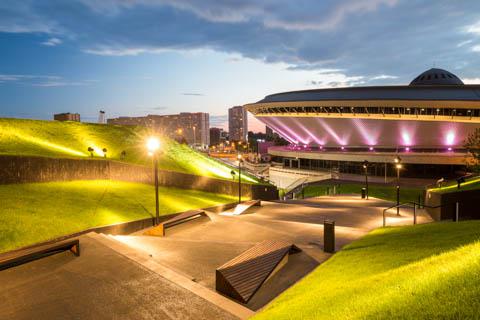Traveling in Katowice
 katowice, Poland
katowice, Poland
Katowice is a city east of Krakow, in the Silesian province of southern Poland. A large dome crowns the Cathedral of Christ the King, built between 1927 and 1955. The adjacent Archdiocesan Museum exhibits Silesian sacred art. The ultramodern Silesian Museum features several glass structures on the site of a former coal mine. It exhibits Polish art and chronicles the history of Upper Silesia. Historically, Katowice is a product of the 19th-century industrial boom, but it only became a city in the interwar period. After WWII, at the height of the Stalinist cult craze, the city was renamed Stalinogrod, but reverted to its old name soon after Comrade Joe died in 1953. Katowice has few significant historical monuments, but it's a major commercial and cultural center and holds sufficient attractions to make it worth a stop.
Neighborhoods & Around
Silesia City Center
Welcome to the very center of Silesia, downtown Katowice where the city's skyline is changing rapidly and the now very walkable Katowice center is a hub of architectural marvels amidst a sea of post-soviet urban and suburban sprawl. In short, totally unique and well worth exploring the many museums, bars, restaurants and clubs populating the ever-changing Silesian landscape. Located mid-way between Katowice and Chorzow on the site of an old 1904 coal mine, the spectacular Silesia City Center easily trumps everything else in the region. Some features include the preserved, red brick St Barbara's Chapel and the remains of the tower that once lowered the miners underground - now the symbol of the commercial center.
Nikiszowiec
The former workers' district of Nikiszowiec is home to some highly unique early 20th century architecture as well as an excellent modern art gallery, a magnificent church and a few additional offbeat attractions. This forgotten attempt at plebeian paradise is earmarked on Silesia's ‘Industrial Monuments Route' and offers intrepid visitors a confounding, yet fascinating glimpse at a foregone age. While not long ago a walk around the neighborhood may have been a dicey prospect, cafes and culture are now beginning to creep into this part of town and you're no longer likely to be the only tourist prowling around. Perfect for a photo essay, charge up your camera battery and off you go.
Giszowiec
Another workers' colony from the same sibling pair behind Nikiszowiec, in the case of Giszowiec, the Zillmans took a completely different conceptual approach, designing an ideal ‘garden city' for local miners based on the ideas of famous British urban planner Ebenezer Howard. Modelled on rural English cottages, the original dwellings of Giszowiec are low, freestanding, sloped roof houses surrounded by garden plots. Built between 1906 and 1910, the neighborhood was arranged as a web of streets extending from Plac Pod Lipami - the central square surrounded by public buildings, shops, a restaurant, school and tavern. The project included a public laundry, a women's bathhouse, theatre, quarantine barracks for the diseased, a prison and a strict set of guidelines to ensure the precious 'English village' atmosphere wouldn't be lost.

 Budget Your Trip is all about finding out how much everything costs so that you can travel cheaper and longer. Created by avid travelers Laurie and Bryan, our goal is to help you plan your next trip on the right budget. With average daily travel costs that are calculated from the budgets of real travelers, plus an analysis of hotel and tour prices, you can find out how much money you need to plan your next adventure. We also have plenty of travel advice, accommodation reviews, and activity suggestions.
Budget Your Trip is all about finding out how much everything costs so that you can travel cheaper and longer. Created by avid travelers Laurie and Bryan, our goal is to help you plan your next trip on the right budget. With average daily travel costs that are calculated from the budgets of real travelers, plus an analysis of hotel and tour prices, you can find out how much money you need to plan your next adventure. We also have plenty of travel advice, accommodation reviews, and activity suggestions.